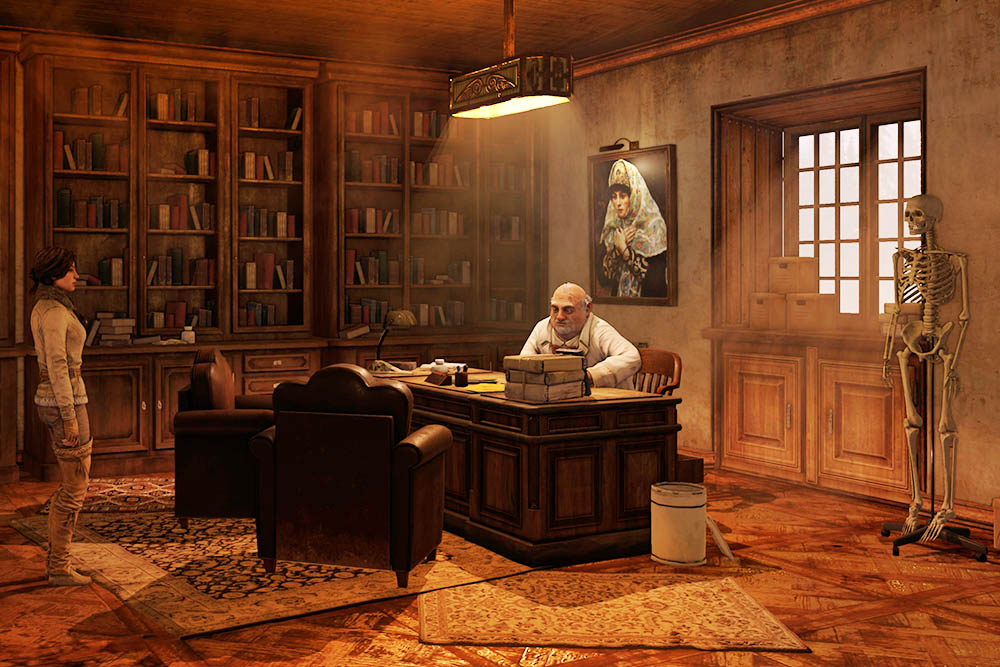Syberia is a steampunk epic centered around the adventures of the main character, Kate Walker, as she travels across Europe and Russia. Beautiful artistry, deep stories, and fantastic elements such as clockwork robots and actual mammoths surviving to the modern era, helped the Syberia franchise emerge as a beloved favorite among the gaming community even at a time when many thought point-and-click puzzle adventure games were going out of style.
It’s been over twelve years since the last game, but fans will be able to continue Kate Walker’s journey when Syberia III launches on April 25 in North America (April 20 in Europe) for PC and console systems, including the Nintendo Switch. Developed and published by French company, Microïds, this will be the first game in the franchise to use full 3D graphics and gameplay, bringing the 20-year-old franchise into a new era. In the third chapter, Kate visits a town called Baranour, which is inspired by the abandoned buildings of Chernobyl, where the remnants of human civilization are taken over by nature.

Author, artist and Syberia creator, Benoît Sokal, spoke with [a]listdaily through French translators to discuss making Syberia III after such long break from the previous game, and what he thought drove such an enduring and loving fan base for the series.
When asked to describe the new game, Sokal said that, “Syberia III is a kind of re-visitation of the 20th century in Europe, because people love to travel there. Kate Walker is this symbol of girls traveling around Europe for long periods of time.”
Sokal then talked about some of his inspirations for the game. “I’m very interested in the landscape of the USSR because it’s wonderful and awful at the same time—like Chernobyl,” he said. “When I began to make Syberia III, my first idea was Chernobyl. I think it’s the most amazing place in the world because nature is very beautiful. There are many animals—it’s an explosion of life, despite the radiation. It was once a major city, like a Soviet Disney World. After the explosion, nature took back its rights.”
We asked Sokal if he was trying to invoke a sense of nostalgia for late 20th Century Europe with the new game and how that feeling related to the game. “The feel of Syberia is a mix of the fantastic and nostalgia because, for me, Europe is about nostalgia,” he replied. “Kate Walker is wandering around fantastic places that were inspired by European cities. People in Europe during the 20th Century liked to wander around many cities, and Kate Walker represents them. Syberia is based on an old Europe, so it’s more about wandering than [going on] a quest.”
While on the topic of nostalgia, we asked Sokal if it was difficult to get back into the series, especially since it’s been so long since Syberia II released. “Yes, a little, because it’s not the same technology,” he admitted. “I made two other games after Syberia II—Paradise and Sinking Island, so it wasn’t possible for me to make Syberia III. When I began Syberia III, the technology changed to real 3D, so I couldn’t make in the same way I made the first two. With those games, I drew everything in Photoshop, and that’s not possible with 3D. But what I lose in detail, I gain in gameplay.”
Sokal further commented on the change in technology by stating: “For me, the comparison between the first games and Syberia III is like the steam locomotive and the electric train. The last steam locomotive was very beautiful, but it was the end of one technology.”
We also asked Sokal about his approach for attracting a new audience to the Syberia franchise. “I work with young people,” he said simply. “We have discussions and arguments about what to change, because my vision of Syberia is from 20 years ago. The only way give a fresh look to Syberia is to work with young people.” His son, Hugo Sokal, helped write and design Syberia III, turning the game series into a kind of family legacy.
Sokal also gave us his thoughts about what made Syberia such an enduring brand after 20 years. “I think that it’s emotion,” said Sokal. “I tried to make it a very emotional game because I come from a comic book background, and my idea was to write a story in the same way I do a book, by introducing emotion for the player. The most important things to me are story and emotion. People remember with their hearts, not their brains.” Sokal also added that, “Kate Walker is the link between all the games in the saga. In the beginning, she was very meek, but she has evolved across the games.”
We asked Sokal for his thoughts about how Syberia managed to stand out when many thought that adventure games were in decline. “I think people need a story—a real story—and people need emotion,” he said. “It’s a basic need from the beginning of humanity. Even when everyone has a VR headset and things like that, they will need stories. You can make that with an adventure game, but not really with a sports or action game. For me, adventure games are crafted for stories, and it (the genre) is the child of novels and comics. It’s a very good way to tell stories.”
Given the 20-year history of the series, we asked Sokal what he hoped players would come away feeling after they completed Syberia III. Echoing his previous statement about stirring emotion, the artist said simply that he hoped that players will cry. “If they cry, I have a win,” said Sokal. “It’s not important that if it’s a book or a video game. If people cry at the end of the story, then we have a win.”

